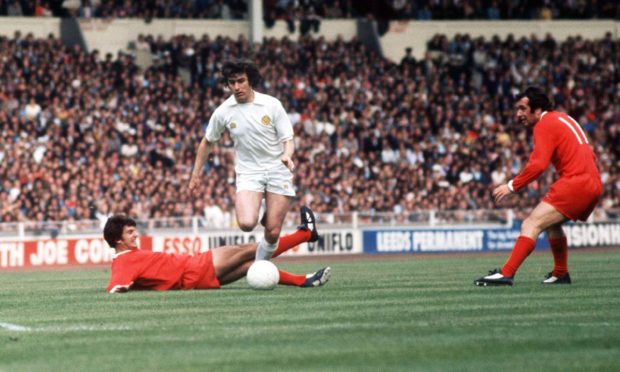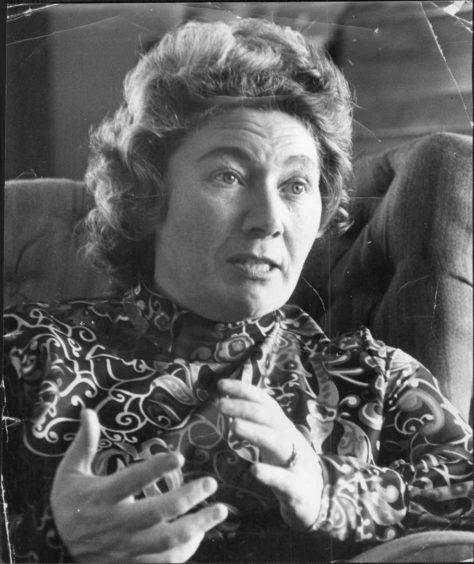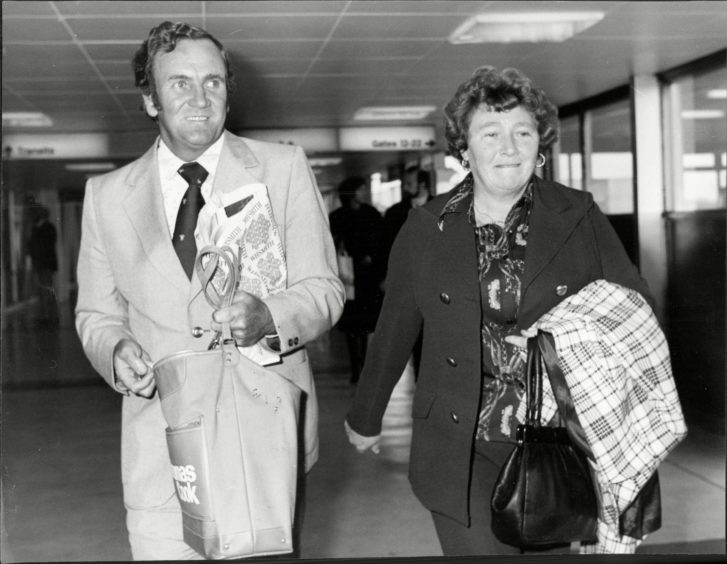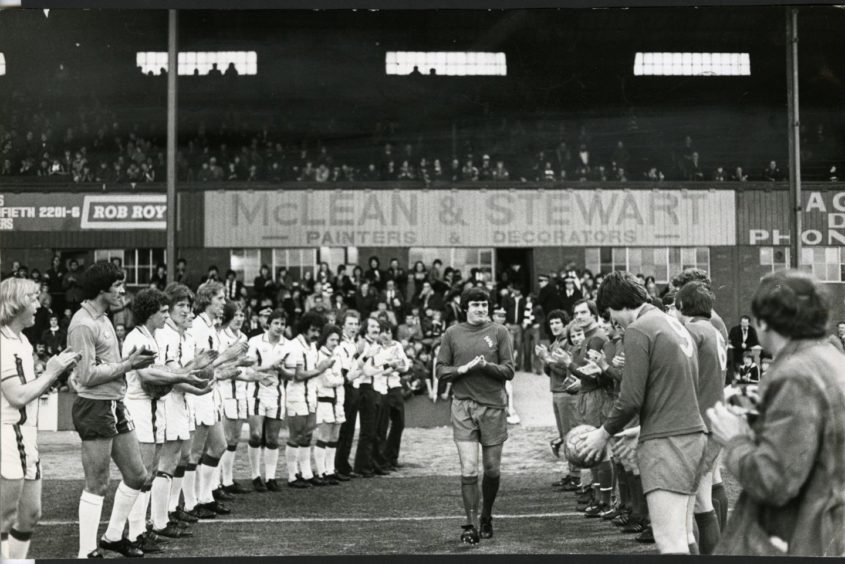Peter Lorimer kept a secret from his Leeds United team-mates after joining the Elland Road ranks as a Dundee schoolboy back in 1962.
Lorimer, who died aged 74 on Saturday, was a distant relation of Leeds manager Don Revie’s wife Elsie who was born in Lochgelly.
Elsie was the niece of former Raith Rovers player Johnny Duncan and attended school in Cowdenbeath.
Keeping it in the family
Lorimer said he did not let it be known because he “did not want accusations flying that my joining Leeds was a question of keeping it in the family”.
The former Eastern and Grove pupil would instead make it on merit alone and went on to make over 700 appearances and score a record 238 goals for Leeds.
Speaking in his 2005 autobiography, Lorimer said: “There were traces of football history in my father’s family but the strength of my lineage is on my mother’s side.
“She was a member of the Duncan family, which was closely related to that of Mrs Elsie
Revie, and the Duncans produced quite a few professional footballers.
“Few people were aware, and I did not let it be known, that I was distantly related to Mrs Revie.”
Lorimer signed for Leeds at the age of 15 after once scoring 176 goals in one season while playing for his school team and Broughty YMCA.
Writing in Lorimer’s testimonial programme in 1978, Revie recalled the mad dash north to catch the final ferry across the Forth to make it to Dundee to sign Lorimer.
Tribute from Don Revie in 1978
Revie said: “In the early sixties – when Leeds were still, remember, a Second Division club – we pulled off a couple of signings that were to prove of inestimable value to the club.
“First – after Maurice Lindley had run the rule over the boy himself – we signed Eddie Gray.
“Maurice couldn’t believe his eyes when he saw for himself.
“Then there was a youngster who had scored an astonishing 176 goals in a season for his school and local YMCA teams.
“Another of our Scottish scouts, Johnny Quinn, spotted him playing in Dundee and saw his potential even though the boy in question was so frail he would have made Allan Clarke look like Tarzan.
“The youngster’s name was Peter Lorimer and even then he packed a terrific shot and possessed that unique, uncoachable knack of scoring goals.
“Peter played for Scotland at Hampden in a schoolboy international – watched by us again – and the next day I had a call from Johnny to say that another club was all set to sign him (we later discovered 28 league clubs were after him).
“So Maurice Lindley and I climbed into my car and set off for Scotland, leaving Leeds about eight o’clock that Sunday night.
“We just managed to squeeze on the ferry – and looking back, I’m glad we did.
“In fact, we were the last car on – at the other side we set off again and I was stopped for speeding as we hurtled through Perth in the middle of the night.
“Fortunately that policeman was a football fan!
“We arrived at Peter’s house at two in the morning, knocked up the whole house and signed him.
“At eight o’clock the other club arrived only to find us having a cup of tea and Peter Lorimer a Leeds player by some hours!”
An injury crisis prompted Lorimer’s debut aged 15 in September 1962 but it would be two-and-a-half years until his next league game under Revie.
It was in 1965-66 that he established himself as a mainstay of the side and during his time at Elland Road he won two First Division titles, FA and League Cup wins, two Inter-Cities’ Fairs Cups and the Charity Shield.
“I soon lost count of the number of goals he rammed in with that incredibly accurate right foot,” said Revie.
“It’s well known that we stopped him shooting at full power at our goalkeepers in training so as not to risk injury.
“Anything Peter connected with inside the box was inevitably a goal.
“His accuracy and power was such that it often looked as if he had hit shots too close to the keeper.
“But he knew there was no chance of stopping it.
“Peter terrorised so many teams in Europe and that was our secret weapon.
“They’d just never seen anything like him.
“And with Scotland he travelled even further afield to show the world his talent.”
Lorimer won 21 caps for Scotland, scoring four goals and played every game at the 1974 World Cup finals in West Germany.
Lorimer produced the impossible
Revie said every member of the Leeds team that challenged for all the game’s top honours at home and in Europe had a role to play.
“Peter’s was more noticeable, perhaps, because he played up front,” he said.
“He produced the impossible so often it was almost commonplace.
“Like the killer goal area instincts of Allan Clarke, the exhilaration and inspiring leadership of Billy Bremner, the cool, sophisticated brilliance of John Giles, the shuddering tackling ability of Norman Hunter, Peter’s stunning shooting was priceless.”
Lorimer left Leeds in 1979 for spells with Toronto Blizzard and Vancouver Whitecaps in the North American Soccer League (NASL).
He returned to England with York City and then in 1983 arrived back at Elland Road to make a further 87 appearances and add 19 goals to his Leeds tally.
Short spells at Hapoel Haifa and at Whitby Town under former Leeds and Scotland team-mate David Harvey brought his playing career to a close in 1986.
Don Revie had also decided to retire that same year.
Lorimer’s former manager moved back to Scotland to Kinross with Elsie following a brief stint with Egyptian Premier League club Al-Ahly of Cairo.
Revie was then diagnosed as suffering from incurable motor neurone disease in 1987 and died at the age of 61 in 1989 in Murrayfield Hospital in Edinburgh.
Elsie was president of the Leeds United Supporters Club following her husband’s death.
She died in 2005 at the age of 77.
Former Courier editor had a front row seat
Adrian Arthur, the former editor of The Courier, was in the Lorimer household as the 15-year-old schoolboy put pen to paper.
He said: “In the early 1960s, I was working as a sub-editor for The Courier in the Bank Street offices.
“This particular night, I was the ‘late sub’, which meant I stayed on after everyone else had gone home to collate any late news which might materialise.
“Just after 2am, the doorman phoned, stating: ‘There’s a gentleman at the door, and he would like to speak to you’.
“It turned out to be Peter Lorimer’s brother, who told me that Leeds manager Don Revie was in the family home in Douglas, and would we like the story and a photo opportunity.
“Along with another colleague, John McQuilkan, we made our way to Douglas and, with duty photographer Bob Allan also in attendance, we witnessed the signing.
“Although The Courier were able to use some of the copy the same morning, the photo appeared in the Evening Telegraph later in the day.”
Peter Lorimer: The Dundee boy who overcame homesickness to become a Leeds legend















